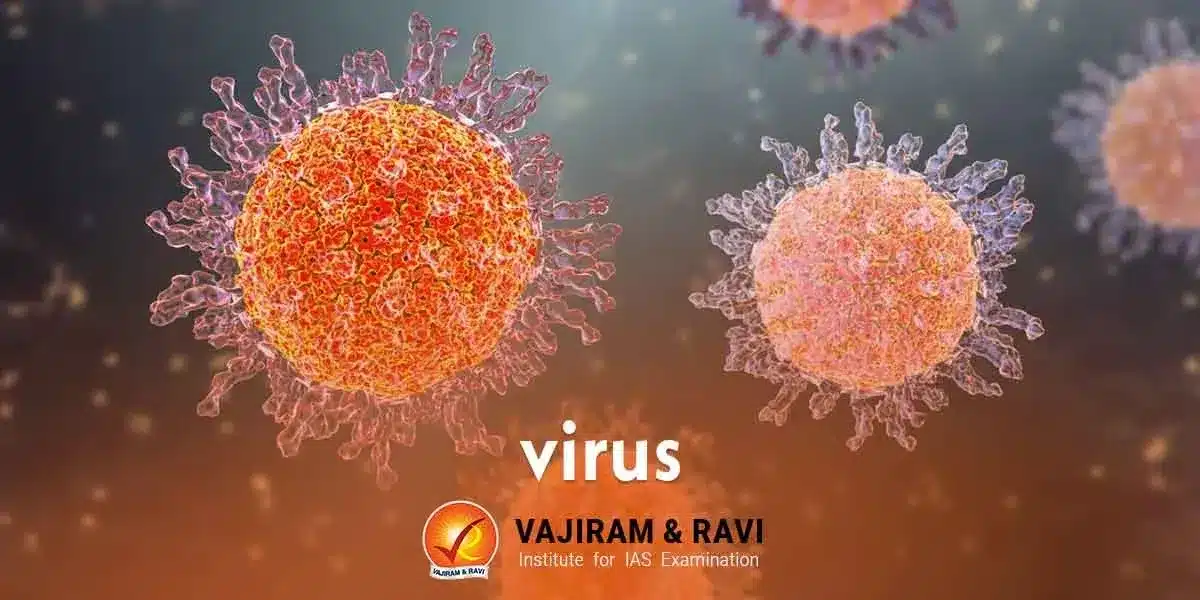Viruses are parasitic entities lacking cells, making them unclassifiable within any specific kingdom. They are sub-microscopic infectious agents that can only replicate inside host cells of living organisms. They range from 20 to 400 nm and can infect all life forms - humans, animals, plants, bacteria. They are found in almost every ecosystem and environment on Earth. Though not classified as living organisms, viruses exhibit biological properties when inside a host cell.
Many fatal epidemics throughout history like smallpox, influenza, HIV/AIDS, Coronavirus, etc. have been caused by viruses. Hence, understanding the nature, structure, and replication of viruses is essential for developing diagnostic tests, vaccines, and antiviral drugs.
About Viruses
Viruses are non-cellular entities with genetic material enclosed in a protein coat called capsid. The viral genome is usually either RNA or DNA. Outside the host, viruses remain inert. But once inside host cells, they utilise the cell machinery to make copies of themselves, often destroying the host cell. Viruses has following properties:
- Viruses, including human pathogens like enteroviruses and caliciviruses, survive in marine environments.
- Viruses can infect bacteria. Bacteriophages (phages) are viruses that specifically infect bacteria. They inject their genetic material into bacterial cells, hijack their machinery, and often lyse the host.
- Viruses like HIV, HBV, and EBV alter host transcriptional activity by modifying DNA methylation, recruiting chromatin-modifying enzymes, or disrupting transcription factors. These changes promote viral replication or disease progression.

Discovery of Virus
The concept of a disease-causing entity smaller than bacteria was first hypothesized in the 1890s.
- Discovery of Mosaic Disease (1892): Dmitri Ivanovsky demonstrates that sap from tobacco plants with mosaic disease remains infectious after bacterial filtration.
- Term "Virus" (1898): Martinus Beijerinck introduces the term "virus" to describe the newly identified soluble and filterable infectious agent.
- Advancements in Virus Study: Viruses grown in plants and animals for pathogenesis research.
- Confirmation of Viral Particulate Nature: Wendell Stanley crystallises the tobacco mosaic virus, confirming its particulate nature and persistent infectivity.
- Technological Advancements: The invention of the electron microscope enabled the visualisation of viruses. The biochemical analysis allowed the determination of viral chemical composition.
- Improvements in virus isolation and detection methods resulted in the discovery of several important human viruses.

Structure of Viruses
Viruses are unique parasites, not classified as plants, animals, or bacteria. Despite their reproductive abilities, viruses aren't living organisms; they rely on host cells for survival. They lack ribosomes and energy-producing mechanisms, relying on host cells for protein synthesis and energy. Viruses exhibit tremendous diversity in size, shape, and composition, but some common structural elements are:
- Genetic Material: This can be single-stranded DNA, double-stranded DNA, single-stranded RNA, or double-stranded RNA. The size of the genome ranges from a few thousand bases for small viruses to over a million bases for giant viruses.
- Capsid: This is a protective layer of protein surrounding the genome. It consists of multiple copies of capsomere subunits tightly arranged to form a shell.
- Based on symmetry, capsids can be helical, icosahedral, or complex.
- Envelope: Some groups of viruses have a membrane envelope made of lipids, proteins, and glycoproteins. Envelopes are acquired by budding from host cell membranes. They mediate viral entry and immune evasion.
- Envelope Protein (Spikes):Glycoprotein spikes protruding from the envelope help attach and enter host cells. Influenza and HIV viruses contain these spike structures.
- Morphology: Based on their morphology, viruses can be classified as naked icosahedral, enveloped icosahedral, naked helical, and enveloped helical.
- Bacteriophages infecting bacteria exhibit head-tail structures.
Difference between Virus and Bacteria
| Parameter | Virus | Bacteria |
| Type | Acellular | Unicellular organism |
| Size | 20 - 400 nm | 0.2 - 10 μm |
| Structure | Capsid with genetic material | Cell wall, cell membrane, cytoplasm, DNA |
| Replication | Require host cells | Can replicate independently |
| Treatment | Antiviral drugs | Antibiotics |
| Diseases caused | COVID-19, influenza, HIV, smallpox | Tuberculosis, pneumonia, tetanus |
Classification of Viruses
They contain only a few elements by which they can be classified: the viral genome, the type of capsid, and the envelope structure for the enveloped viruses.
- Host Organism Infected:
- Animal Viruses, Plant Viruses, Bacteriophages
- Based on structure: Viruses can be classified into four types:
- Helical: Long spiral capsids e.g. Influenza
- Icosahedral: Polygonal capsids with 20 faces e.g. Poliovirus
- Enveloped: Lipid bilayer covering capsid e.g. HIV, Coronavirus
- Complex: Intricate structures e.g. Bacteriophages (viruses that infect bacteria.
- The viral genome is tightly packed into a small volume within the capsid. Animal viruses have genome sizes ranging from 3,000 to 1,000,000 nucleotide bases.
- Nature of Nucleic Acid:
- DNA Viruses: Adenovirus, Herpesvirus, Hepadnavirus
- RNA Viruses: Picornavirus, Orthomyxovirus, Rhabdovirus
Viruses are classified by the Baltimore system based on their type of genetic material. There are seven groups:
| Group | Nucleic Acid | Example Viruses |
| I | dsDNA* | Adenovirus, Herpesvirus, Poxvirus |
| II | ssDNA* | Parvovirus |
| III | dsRNA | Reovirus |
| IV | (+)ssRNA | Picornavirus, Togavirus |
| V | (-)ssRNA | Orthomyxovirus, Rhabdovirus |
| VI | ssRNA-RT* | Retrovirus - HIV |
| VII | dsDNA-RT | Hepadnavirus - Hepatitis B |
(*ds - Double stranded, *ss - Single-stranded, *RT - Reverse transcribing)
This genetic material of viruses encodes proteins and enzymes vital for viral replication inside host cells.
Reproduction in Viruses
They cannot replicate on their own but rather depend on their host cell's protein synthesis pathways to reproduce. There are two processes used by viruses to replicate:
- Lytic Cycle: This is the productive viral replication cycle exemplified by bacteriophages. It has the following stages:
- Attachment: Viral spikes bind to specific receptors on the host cell surface
- Penetration: The viral genome enters into the cell cytoplasm through endocytosis or membrane fusion.
- Replication: Viral genes and genome hijack the cell machinery to produce viral proteins and nucleic acid.
- Assembly: New viral particles are assembled using the replicated components.
- Release: Cloned viruses break open the host cell by lysis and spread the infection.
- Through this cycle, a virus can produce thousands of progenies from a single host cell in a matter of hours.
- Lysogenic Cycle: In this cycle, the viral genome gets incorporated into the host DNA. It persists in a dormant state as a prophage without replication.
- The prophage later enters the lytic cycle in response to environmental triggers.
- In latent infections like herpes, the viral genome is maintained in host cells in inactive form for later reactivation.
- Retroviruses like HIV integrate their genome into the host DNA.

Applications and Significance of Viruses
Scientists have harnessed the biology of viruses for the development of new tools and applications in molecular biology, medicine, and other streams. Despite the havoc they create, viruses also have some beneficial applications:
- Vaccine development: Attenuated or inactive viruses are used to produce vaccines and immunize against viral diseases.
- For example, the Oral polio vaccine (OPV) from attenuated poliovirus led to the near eradication of poliomyelitis.
- Gene therapy vectors: Viruses can transfer genetic material into cells, enabling gene therapy.
- For example, the Adeno-associated virus (AAV) has been used in clinical trials for treating blindness, haemophilia, and neurodegenerative diseases.
- Cancer treatment: Viruses specifically able to infect and kill cancer cells are being studied as oncolytic viruses for cancer treatment.
- An example is the herpesvirus T-Vec which is FDA-approved for treating melanoma.
- Bacteriophages: Viruses infecting bacteria called bacteriophages have been utilised for killing strains of pathogenic bacteria like treating antibiotic-resistant superbugs.
- Phage therapy cocktails are commercially produced and prescribed in Russia and parts of Europe.
- Biological control: Certain viruses attacking insect pest species can be formulated as biopesticides for controlling costly crop infestations.
- An example is the use of baculoviruses against gipsy moth infestations in North America.
- Molecular biology: Due to their structural simplicity, viruses serve as excellent model systems and tools to examine fundamental cellular processes like gene expression, genome replication, viral-host interactions, etc. that provide wider biological insights.
- Studies of tobacco mosaic virus led to the discovery of the first virus genome enabling advances in molecular biology.

Diseases Caused by Viruses
Viruses account for several troublesome diseases in humans ranging from mild ailments to severe life-threatening conditions.
| Virus Families | Diseases | Mode of Transmission |
| Orthomyxoviridae | Influenza, bird flu | Airborne route |
| Picornaviridae | Poliomyelitis, common cold, hepatitis A | Faeco-oral route |
| Togaviridae | Rubella, chikungunya | Mosquito vectors |
| Flaviviridae | Dengue, yellow fever, hepatitis C | Mosquito vectors |
| Retroviridae | HIV/AIDS | Body fluids, blood |
| Herpesviridae | Herpes, chickenpox, shingles | Contact, sexual, saliva |
| Hepadnaviridae | Hepatitis B | Blood, body fluids |
| Paramyxoviridae | Measles, mumps | Airborne route |
| Rhabdoviridae | Rabies | The bite from an infected host |
| Poxviridae | Smallpox | Close Contact |
| Coronaviridae | SARS, MERS, COVID-19 | Respiratory droplets |
Viruses are unique microscopic infective agents that replicate only within host cells. Though tiny in size, they have an outsized impact on ecology, evolution, and human disease. Developing antiviral strategies is an ongoing battle due to the immense diversity and mutability of viruses as parasites dependent on hosts. Virology research on emerging viral threats, and developing new-generation vaccines and antiviral drugs will remain priorities for improving public health outcomes.
Virus UPSC PYQs
Q1: Consider the following statements: (UPSC Prelims 2025)
- No virus can survive in ocean waters.
- No virus can infect bacteria.
- No virus can change the cellular transcriptional activity in host cells.
How many of the statements given above are correct?
a) Only one
b) Only two
c) All three
d) None
Ans: (d)
Last updated on January, 2026
→ Check out the latest UPSC Syllabus 2026 here.
→ Join Vajiram & Ravi’s Interview Guidance Programme for expert help to crack your final UPSC stage.
→ UPSC Mains Result 2025 is now out.
→ UPSC Notification 2026 is scheduled to be released on January 14, 2026.
→ UPSC Calendar 2026 has been released.
→ UPSC Prelims 2026 will be conducted on 24th May, 2026 & UPSC Mains 2026 will be conducted on 21st August 2026.
→ The UPSC Selection Process is of 3 stages-Prelims, Mains and Interview.
→ Prepare effectively with Vajiram & Ravi’s UPSC Prelims Test Series 2026 featuring full-length mock tests, detailed solutions, and performance analysis.
→ Enroll in Vajiram & Ravi’s UPSC Mains Test Series 2026 for structured answer writing practice, expert evaluation, and exam-oriented feedback.
→ Join Vajiram & Ravi’s Best UPSC Mentorship Program for personalized guidance, strategy planning, and one-to-one support from experienced mentors.
→ UPSC Result 2024 is released with latest UPSC Marksheet 2024. Check Now!
→ UPSC Toppers List 2024 is released now. Shakti Dubey is UPSC AIR 1 2024 Topper.
→ Also check Best UPSC Coaching in India
Virus FAQs
Q1. What are the components of a virus?+
Q2. How are viruses classified based on structure?+
Q3. What is an example of an enveloped virus?+
Q4. What are the categories under the Baltimore classification?+
Q5. Which virus has the largest genome?Which virus has the largest genome?+

















